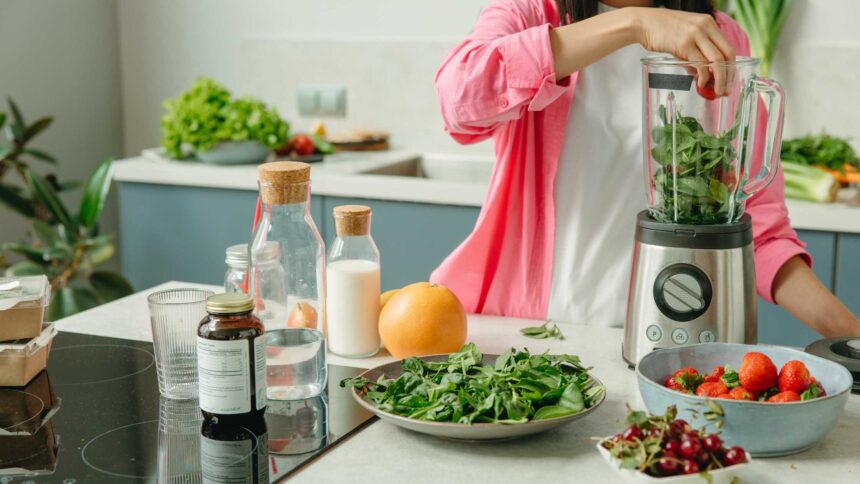A blender is a kitchen appliance that uses high-speed rotating blades to liquefy, mix, or soften food and liquids. It’s a versatile tool that can be used for a wide range of Cookery tasks, from making smoothies and soups to preparing sauces and baby food. In this comprehensive guide, we will delve into the details of blenders, exploring how they work, the different types available, their advantages and disadvantages, and why they are essential in modern kitchens.
How a Blender Works?
Blenders function based on a straightforward but efficient principle. A powerful motor drives a set of sharp blades at high speeds within a container. When ingredients are added to the container and the blender is turned on, the blades create a vortex that draws the contents towards the centre, where they are rapidly chopped and mixed. The friction generated by the blades also helps to heat the mixture, which can be beneficial for certain recipes.
Types of Blenders

There are several types of blenders available, each with its unique features and applications:
- Hand Blenders/Immersion Blenders: Also known as stick blenders, these handheld devices are ideal for small-scale tasks like blending soups, softening sauces and making smoothies directly in a pot or container.
- Countertop Blenders: These are the most common type of blender, featuring a stationary base and a glass or plastic jar. They are suitable for a wide range of blending tasks, from making smoothies to crushing ice.
- Commercial Blenders: Designed for heavy-duty use in restaurants and cafes, commercial blenders are more powerful and durable than their countertop counterparts.
- Personal Blenders: Compact and portable, personal blenders are perfect for individuals on the go. They are typically designed for making single servings of smoothies or shakes.
Advantages and Disadvantages of Blenders
Blenders offer numerous advantages, making them essential in modern kitchens:
- Versatility: Blenders can handle a wide range of tasks, from making smoothies to grinding grains.
- Efficiency: Blending ingredients is often faster and easier than using other methods.
- Convenience: Blenders are easy to clean and maintain.
However, a few drawbacks should be taken into account:
Noise: Blenders can be quite noisy, especially when used at high speeds.
Limited Capacity: Some blenders may have limitations on the quantity of ingredients that can be processed at once.
Cost: High-quality blenders can be expensive.
Importance of a Blender

A blender is an essential appliance for anyone who enjoys cooking or preparing healthy meals. It offers numerous benefits, including:
Improved Nutrition: Blenders make it easy to integrate fruits, vegetables, and other healthy ingredients into your diet.
Time Savings: Blending ingredients can save time compared to manual methods.
Cost-Effective: By making your smoothies, soups, and other foods, you can save money on pre-packaged options.
List of Top Brands, Costs, and Reviews of Blenders in India
1. Preethi
Cost: ₹2,000 – ₹7,000
Reviews: Preethi blenders are known for their durability and reliability. They offer a range of models catering to different needs from basic blending to heavy-duty tasks.
2. Bajaj
Cost: ₹1,500 – ₹5,000
Reviews: Bajaj blenders are appreciated for their affordability and decent performance. They are a favoured option for budget-conscious buyers.
3. Philips
Cost: ₹2,500 – ₹10,000
Reviews: Philips blenders are well-regarded for their sleek design and good blending performance. They offer models with various features such as multiple speed settings and detachable blades for easy cleaning.
4. Wonderchef
Cost: ₹2,000 – ₹8,000
Reviews: Wonderchef blenders are known for their stylish looks and functionality. They often combine attractive design with decent blending power, making them popular in the market.
5. Prestige
Cost: ₹1,500 – ₹6,000
Reviews: Prestige blenders are known for their resilient build and ease of use. They offer a range of models that cater to different blending needs, from basic to more advanced functions.
6. Butterfly
Cost: ₹1,500 – ₹5,000
Reviews: Butterfly blenders are appreciated for their value for money. They are robust and offer good performance for blending tasks, making them a reliable choice.
7. Havells
Cost: ₹2,000 – ₹8,000
Reviews: Havells blenders are known for their innovative features and efficient performance. They are considered reliable for everyday blending tasks and come in various capacities to suit different household needs.
8. Oster
Cost: ₹3,000 – ₹12,000
Reviews: Oster blenders are well-regarded for their strong motors and durability. They are known for their ability to handle tough blending tasks such as crushing ice and making smoothies.
9. Vitamix (High-end option)
Cost: ₹20,000 and above
Reviews: Vitamix blenders are top-of-the-line products known for their exceptional blending performance and durability. They are highly recommended for professional use and serious home cooks.
10. NutriBullet (High-end option)
Cost: ₹7,000 – ₹15,000
Reviews: NutriBullet blenders are popular for their compact size and powerful blending capabilities. They are especially favoured for making smoothies and are known for their ease of use and cleaning.




